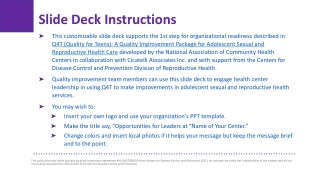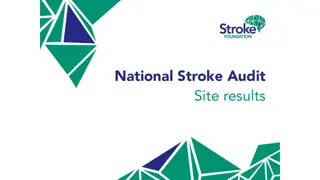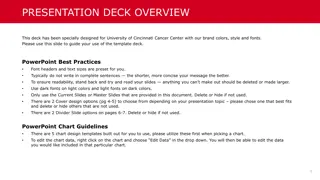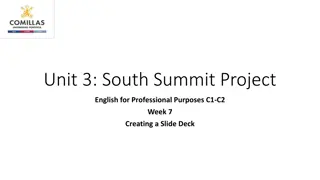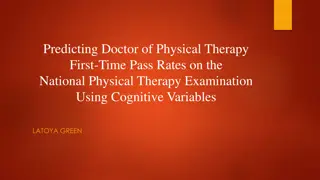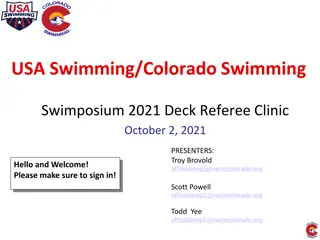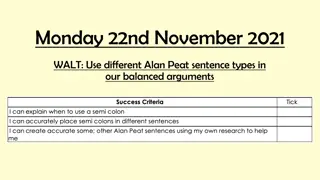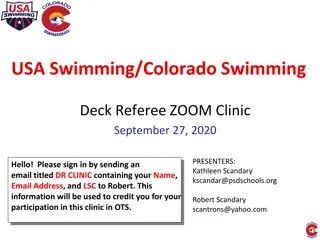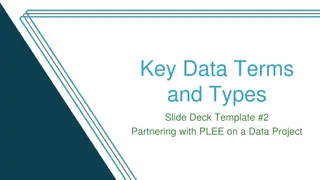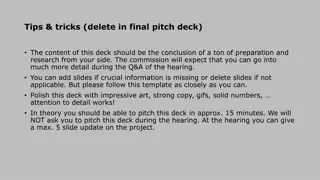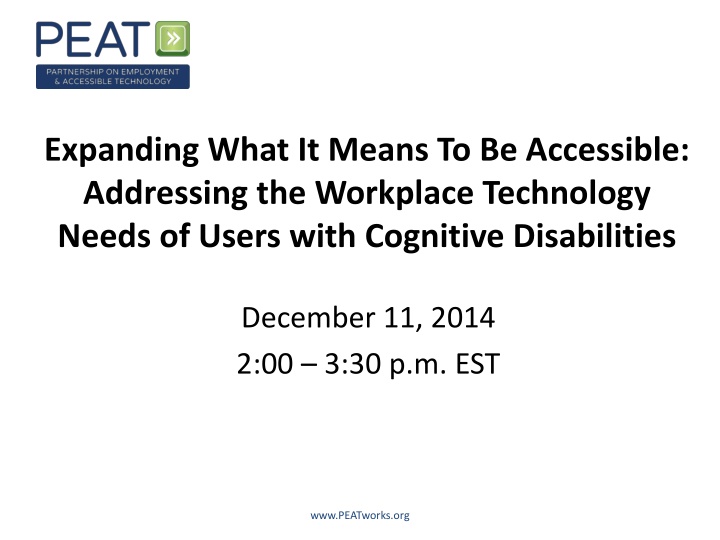
Addressing Workplace Technology Needs of Users with Cognitive Disabilities
Join the discussion on workplace technology accessibility for users with cognitive disabilities. Explore common themes, research suggestions, and collaborate for a more inclusive online environment. Featuring experts like Peter Blanck and Lisa Seeman. Engage with PEATworks to expand what it means to be accessible.
Download Presentation

Please find below an Image/Link to download the presentation.
The content on the website is provided AS IS for your information and personal use only. It may not be sold, licensed, or shared on other websites without obtaining consent from the author. If you encounter any issues during the download, it is possible that the publisher has removed the file from their server.
You are allowed to download the files provided on this website for personal or commercial use, subject to the condition that they are used lawfully. All files are the property of their respective owners.
The content on the website is provided AS IS for your information and personal use only. It may not be sold, licensed, or shared on other websites without obtaining consent from the author.
E N D
Presentation Transcript
Expanding What It Means To Be Accessible: Addressing the Workplace Technology Needs of Users with Cognitive Disabilities December 11, 2014 2:00 3:30 p.m. EST www.PEATworks.org
Your Session Chairs Jim Tobias PEAT Strategic Partner & Subject Matter Expert Julia Bascom Director of Programs, Autistic Self Advocacy Network www.PEATworks.org 2
Logistics Audio is also available over a phone line: Dial in number: 1-866-365-3921 Conference code: 7247886139# Submit questions at any time during the presentation: Type directly into the Q&A window your screen Email info@PEATworks.org Tweet @PEATworks Captioning is available at: http://bit.ly/1zK2oet www.PEATworks.org 3
ASAN-PEAT Collaboration ASAN-PEAT online national dialogue hosted in 2013: Join the Conversation: Improving the Accessibility of Online Tools for Workers with Intellectual Disabilities Report on data from the dialogue that reviews common themes and suggests potential next steps for research, policy, and programming www.PEATworks.org 4
Your Moderator Richard Crespin CEO, CollaborateUp Senior Fellow, U.S. Chamber of Commerce www.PEATworks.org 5
Todays Panelists Peter Blanck, Chairman, Syracuse University s Burton Blatt Institute and author of e:Quality: The Struggle for Web Accessibility by People with Cognitive Disabilities Lisa Seeman, Facilitator of the Cognitive and Learning Disabilities Accessibility Task Force (COGA) Under WCAG and PF Greg McGrew, Product Testing Lab Coordinator , Assistive Technology Partners (ATP), University of Colorado-Denver Emily Shea Tanis, Associate Director of Research, University of Colorado Coleman Institute for Cognitive Disabilities www.PEATworks.org 6
Peter Blanck Chairman, Syracuse University s Burton Blatt Burton Blatt Institute Author, eQuality: The Struggle for Web Accessibility by People with Cognitive Disabilities www.PEATworks.org 7
eQuality www.PEATworks.org 8
Lisa Seeman, Athena I.C.T Facilitator of the Cognitive and Learning Disabilities Accessibility Task Force (COGA) Under WCAG and PF www.PEATworks.org 9
COGA The Cognitive and Learning Disabilities Accessibility Task Force is a task force of the Protocols and Formats Working Group (PFWG) and the Web Content Accessibility Guidelines Working Group Aim: To improve web accessibility for people with cognitive and learning disabilities This will begin with research and gap analysis. The group will develop draft proposed guidance and techniques to make web content, content authoring, and user agent implementation accessible and more useable by people with cognitive and learning disabilities. It will also review existing techniques, consider ways to improve them, and build new techniques where necessary. www.PEATworks.org 10
Cognitive Disabilities Conditions that impact a person s ability to use a website include: Memory Dyslexia visual or auditory Dementia short term and working memory Reading text Problem solving Keeping focused (attention span) Computation (for example calculations) www.PEATworks.org 11
Cognitive Disabilities The largest group of disabilities are people with cognitive disabilities Meanwhile, many systems have become more and more complex Web applications TV interfaces, heating Phone systems www.PEATworks.org 12
Cognitive Disabilities Some advantages of Neuro-Diversity in the workplace; Out-of-the Box thinking: Study of 102 entrepreneurs in the U.S. showing that 35% identified themselves as dyslexic (http://buswk.co/1yDG1FC) Genetic link between a dopamine receptor gene variation associated with ADHD and the tendency to be an entrepreneur (http://bit.ly/1x5Vvqc) Strong points are often stronger Experience of the aging community Understand your market www.PEATworks.org 13
The Work Ahead of Us Users Tech Gap Analysis Roadmap Techniques All on our wiki www.PEATworks.org
What Might We End Up With? Simple techniques for everyone Supportive material Technique structure Accessibility for Cognitive and LD Semantics for adaptive interfaces Techniques for specific user groups Meta data to find the right version www.PEATworks.org
Example: Separate Form & Content Chapter 1 introduction to accessibility 1.2 Accessibility and CSS Tools Key points Clear structure in mark up via heading levels Easier to follow :before for symbols Colors for heading levels www.PEATworks.org
User Needs Differ Dyslexia or Dyscalculia Alzheimer's or Aphasia SAVE SAVE Conclusion use text with the symbol www.PEATworks.org
Greg McGrew, MEBME Product Testing Lab Coordinator | Assistive Technology Partners Department of Bioengineering University of Colorado Denver | Anschutz Medical Campus www.PEATworks.org 18
Rehabilitation Engineering Research Centers on Technology for People with Cognitive Disabilities RERC-ACT (2009-2014) Research Projects Development Projects RERC-ATACI (2014-2019) Research Projects Development Projects www.PEATworks.org 19
Usability Testing 50 products used by people with cognitive disabilities Mix of AT and general consumer products Open box usability testing of basic entry-level product functions Tested with people with mild to moderate cognitive disabilities www.PEATworks.org 20
Usability Testing www.PEATworks.org 21
Notable Issues Process issues Recruitment Use of standard measures Participants interest in pleasing Product design issues Too many input options impede user success Users like products that talk to them Touch screens are not ideal input mediums www.PEATworks.org 22
Future Work Usability testing new and emerging technologies Smartphones Tablets Wearables Smarthome environments www.PEATworks.org 23
Google Glass(like) www.PEATworks.org 24
Future Work Investigation of touch screen UI designs Among current input element designs (buttons, layouts), which inhibit and which enhance success in product use for people with cognitive disabilities? Inform development of standards for products used by people with cognitive disabilities www.PEATworks.org 25
Shea Tanis, Ph.D Associate Director of Research Coleman Institute for Cognitive Disabilities at the University of Colorado www.PEATworks.org 26
Cognitive Disability PREVALENCE OF COGNITIVE DISABILITY IN THE U.S., FY 2013 Severe, Persistent Mental Illness 12.21 Million Intellectual Disability 5.08 Million 41% 17% 18% Alzheimer's 5.38 Million 3% 21% Brain Injury 6.43 Million Stroke .80 Million Total: 29.90 Million Persons Source: Braddock, D., Coleman Institute and Department of Psychiatry, University of Colorado, 2015. www.PEATworks.org 27
Number of Supported Employment Workers in the U.S. Declines 7% 2009-2013 Source: Braddock, D., Coleman Institute and Department of Psychiatry, University of Colorado, 2015. www.PEATworks.org 28
Changing the Culture: Person to Environment Fit Disability is a natural part of the human experience Technology becomes a critical support to enhance functioning and improve the person to environment fit Well matched technology can reduce and even eliminate functional limitations Cognitively accessible technologies www.PEATworks.org 29
Cognitively Accessible Technologies Cognitive Accessibility: Environments, technology, and materials that are cognitively accessible are those that incorporate design features to ensure that people with limitations in cognitive abilities--including language ability and auditory reception, reasoning and idea production, memory and learning, visual perception, cognitive speed, and knowledge and achievement are able to access those environments and use the technology and materials. Wehmeyer (2014) Coleman Institute Cognitive Technology Database www.PEATworks.org 30
Employers & Technology Providers Embrace the person to environment fit model Explore cognitively accessible technologies Employ people with cognitive disabilities Develop user centered product and service design Build partnerships Meaningfully integrate principles of technology and information access www.PEATworks.org 31
Rights of People with Cognitive Disabilities to Technology and Information Access The Rights of People With Cognitive Disabilities to Technology and Information Access David Braddock, Jeffery Hoehl, Shea Tanis, Enid Ablowitz, and Laura Haffer 206
Rights of People with Cognitive Disabilities to Technology and Information Access Abstract Information and communication technologies are ubiquitous and valuable tools for billions of people worldwide today. Yet people with cognitive disabilities, particularly individuals with intellectual and developmental disabilities, have quite limited access to such technologies. This article presents the case for mounting significant efforts to advance the rights of millions of people with cognitive disabilities to technology and information access. A formal statement of these rights is presented, formulated by professionals and consumers representing a variety of disciplines and perspectives. The statement is currently endorsed by 190 national, state and local organizations in the developmental disabilities field in the United States.
Making Legislative History March 3, 2014 Colorado House and Senate unanimously pass a Joint Resolution on The Rights of People with Cognitive Disabilities to Technology and Information Access Sample of Endorsing Organizations: ASAN, AAIDD, The Arc, ANCOR, CCD, SABE, NADD, ATAP, Autism Society of America, APSE, AUCD, Burton Blatt Institute; several State DD Councils, RESNA, Council on Quality and Leadership, Institute for Matching Person and Technology, Lutheran Services in America Disability Network, Harvard Law School Project on Disability, etc. Endorse the Declaration at http://www.colemaninstitute.org/declaration www.PEATworks.org 34
Contact Information Shea Tanis, Ph.D. 3825 Iris Avenue, Suite 200 Boulder, CO 80301 303.492.0639 Shea.tanis@cu.edu www.colemaninstitute.org www.stateofthestates.org www.PEATworks.org 35
QUESTIONS? www.PEATworks.org 36
Thank You. info@PEATworks.org http://PEATworks.org www.PEATworks.org 37

